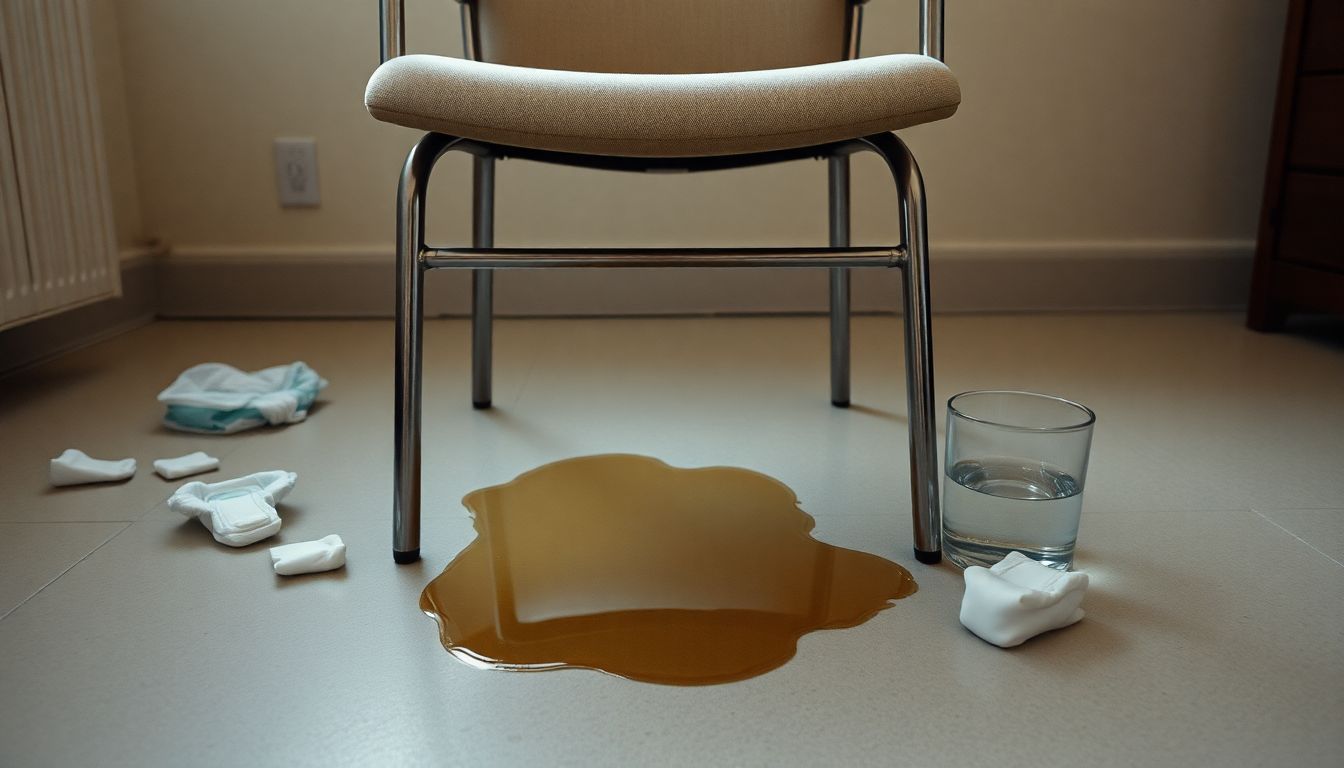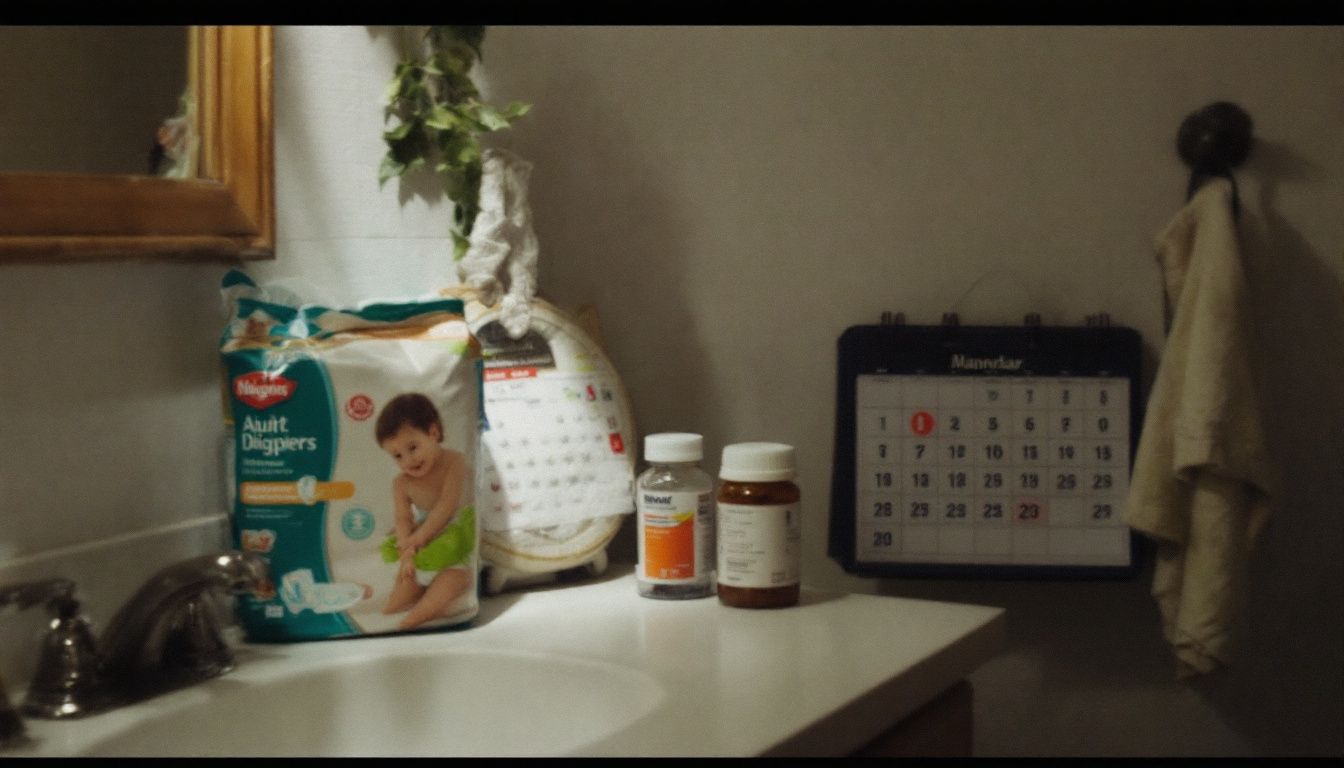Dealing with urinary incontinence can feel frustrating and embarrassing. This common condition affects millions, especially women. In this article, you’ll learn the causes, symptoms, and treatments to manage it better.
Thank you for reading this post, don't forget to subscribe!Take control—keep reading!
Key Takeaways
- Urinary incontinence affects millions, especially women. About 1 in 4 adult women experience it, with types like stress and urge incontinence being common.
- Risk factors include childbirth, aging, obesity, and medical conditions like Parkinson’s or multiple sclerosis. These can weaken bladder control over time.
- Symptoms include urine leakage during activities (coughing/laughing), frequent urination, and waking at night to pee (nocturia). Diagnosis involves exams, tests like ultrasounds or urodynamics, and sometimes bladder diaries.
- Treatment options range from lifestyle changes (diet/exercise) to medications like anticholinergics or Botox injections. Severe cases may need surgery such as sling procedures for extra support.
- Open conversations reduce stigma and help people seek solutions. Support groups offer advice on bladder training, pelvic floor exercises (Kegels), and resources for better management.
Understanding Urinary Incontinence
Urinary incontinence happens when you lose control over your bladder. It can affect anyone and may lead to different challenges in daily life.
Common condition affecting individuals, particularly women
Loss of bladder control affects millions, especially women. Studies show that about 1 in 4 adult women experience some form of urinary incontinence. Common types include stress incontinence, often caused by sneezing or laughing, and urge incontinence, linked with an overactive bladder.
Factors like childbirth, aging, obesity, and medical conditions increase the risk. Pelvic floor disorders and neurological disorders like multiple sclerosis can contribute too. Treatment varies based on the type but always starts with understanding symptoms better—leading to diagnosis methods discussed next….
Manifests in various forms: stress, urge, overflow, and functional incontinence
Urinary incontinence can show up in different ways. Each type has unique causes and symptoms.
- Stress Incontinence
This happens with pressure on the bladder. It can occur when laughing, coughing, sneezing, or exercising. Weak pelvic floor muscles are often the cause. - Urge Incontinence
This involves a sudden, strong urge to urinate. The bladder contracts even when not full, causing leaks. Overactive bladder is a common reason for this type. - Overflow Incontinence
It occurs when the bladder doesn’t empty fully. Small amounts of urine leak frequently. Causes include an enlarged prostate or bladder nerve damage. - Functional Incontinence
This happens if physical or mental issues prevent getting to a toilet in time. Conditions like Parkinson’s disease or arthritis may lead to this.
Each type impacts daily life differently but can be managed with proper care and treatment options.
Risk factors: childbirth, aging, obesity, and medical conditions
Some factors increase the chance of developing urinary incontinence. Understanding these can help you take steps to reduce risks.
- Childbirth strains the pelvic floor muscles, leading to weakened bladder control. Women who have had vaginal deliveries are more likely to experience stress incontinence.
- Aging naturally weakens muscles, including those supporting the urinary system. Older adults may face overactive bladder or urge incontinence more often.
- Obesity adds pressure on the abdomen and bladder. This extra weight increases stress on pelvic organs, worsening symptoms over time.
- Medical conditions like Parkinson’s disease or multiple sclerosis disrupt signals between the brain and bladder. These issues can lead to functional incontinence or mixed incontinence forms.
Symptoms and Diagnosis
Many people experience unplanned urine leakage or need to pee often. A doctor can help determine the cause through exams and tests like urinalysis or pelvic ultrasound.
Involuntary urine leakage, frequent urination, nocturia
Urinary incontinence can show up in different ways. Key symptoms include involuntary leakage of urine, frequent trips to the bathroom, and waking at night to urinate (nocturia).
- Uncontrolled urine leakage happens when your bladder muscles don’t work as they should. It might occur during activities like coughing or sneezing.
- The constant need to urinate occurs due to an overactive bladder or other urinary system issues. This can disrupt daily routines.
- Waking up several times at night to pee is called nocturia. It can result from aging, excessive fluid intake before bed, or health conditions like diabetes.
Understanding these signs early can lead to better treatment plans and outcomes!
Diagnosis involves health history review, physical examination, and possibly tests
Diagnosis plays a key role in managing urinary incontinence. It helps identify the type and severity of the condition.
- Doctors review your health history. They ask about symptoms, lifestyle, and possible triggers like childbirth or obesity.
- A physical exam checks for issues with the pelvic floor muscles or bladder neck. This may include a pelvic ultrasound to find problems.
- You might keep a bladder diary. It tracks urination patterns, urine output, and any accidents over time.
- Tests like urodynamic testing analyze bladder function. These tests measure pressure and how well your bladder holds and releases urine.
- A urine test rules out infections like UTIs or urinary stones that can cause similar symptoms.
- Sometimes imaging tests are used for complex cases, such as pelvic organ prolapse diagnosis or nerve disruptions caused by Parkinson’s disease.
These steps guide treatment plans based on individual needs for better bladder control and quality of life improvement.
Treatment Options
Treatment depends on the type and severity of incontinence. Options range from exercises to surgeries, offering hope for better bladder control.
Lifestyle changes, pelvic floor exercises, medications, medical devices, surgical interventions
Managing urinary incontinence may seem overwhelming, but many effective options can help. Here are some ways to improve bladder control and reduce symptoms.
- Lifestyle changes like reducing caffeine, alcohol, and bladder irritants can help. Maintaining a healthy weight and managing constipation with a fiber-rich diet may also ease symptoms.
- Pelvic floor exercises or Kegels strengthen the pelvic muscles. These exercises improve control and reduce leaks over time. A physical therapist can teach proper techniques.
- Medications, such as solifenacin (Vesicare), can relax the bladder muscles. These drugs treat conditions like overactive bladder or urge incontinence.
- Absorbent pads provide protection for mild leaks during daily activities. Pessaries offer internal support for women experiencing stress incontinence.
- Surgical interventions, like sling procedures or bladder neck suspension, aim to restore support around the bladder. Botox injections may also calm overactive muscles causing leaks.
Open discussions about these treatments often make it easier to explore options that fit your needs…
Importance of consulting healthcare professionals for individualized treatment plans
Talking with healthcare professionals helps find the right treatment. Not all cases of urinary incontinence are the same. Conditions like stress incontinence or overactive bladder may need different approaches.
Doctors can suggest things like physical therapy, medications, or surgical options based on your health needs.
Personalized plans take into account factors such as age, medical history, and lifestyle. For instance, pelvic floor exercises might work well for some but not for others with severe symptoms.
A customized approach ensures better results and improves quality of life—leading into treatment choices that fit each unique case.

Overcoming Urinary Incontinence
Managing urinary incontinence takes patience and persistence. Different methods can ease symptoms and improve daily life, depending on individual needs.
Behavioral strategies like bladder training
Bladder training helps control urination and improves bladder health. It teaches your bladder to hold urine longer, reducing frequent trips to the bathroom. Start by keeping a bladder diary.
Track when you urinate, leak, or feel the urge to go. Use this information to set timed schedules for bathroom visits.
Gradually increase the time between trips as your bladder adjusts. Avoiding bladder irritants like caffeine and spicy foods can make training more effective. Pelvic floor exercises, such as Kegel exercises, also strengthen muscles that support better control during this process.
Medications for symptom management
Bladder training might not work for everyone. Medications can help manage symptoms of urinary incontinence. Anticholinergics calm an overactive bladder and reduce urge incontinence episodes.
Examples include oxybutynin and tolterodine. Beta-3 adrenergic agonists, like mirabegron, relax the bladder muscles to improve storage capacity.
Some patients benefit from botox injections directly into the bladder muscle. This treatment is especially useful for those with severe overactive bladder problems or neurological disorders like multiple sclerosis.
Always consult a healthcare provider before starting any medication or treatment plan.
Surgical options for severe cases
For severe urinary incontinence, surgery might help restore control. Sling procedures are common options for both men and women. Surgeons use a strip of mesh or your tissue to create support under the urethra or bladder neck.
This helps stop leaks by providing extra strength where needed.
Bladder neck suspension is another method often recommended for stress incontinence. It involves lifting and securing the bladder neck with stitches to prevent urine leakage during physical activity.
Both techniques have proven success rates but come with risks like infection or difficulty urinating post-surgery. Always discuss these steps with your healthcare provider to ensure they fit your specific needs.
Encouraging Open Discussions
Talking openly about urinary incontinence removes shame and promotes healing—start conversations to find support, solutions, and hope.
Reducing stigma and encouraging seeking help
Open conversations can change lives. Talking about female urinary incontinence or stress incontinence reduces shame and builds trust. Many feel alone, but about 25 million adults in the U.S. face this issue.
Sharing stories encourages others to seek help.
Support groups and resources make a big difference too. They offer guidance on kegel exercises, bladder training, and treatments like percutaneous tibial nerve stimulation (PTNS). This support improves mental health and quality of life—leading to better bladder control overall.
Exploring resources and support groups for individuals dealing with urinary incontinence
Talking about urinary incontinence can feel uncomfortable. Joining a support group offers a safe space to share experiences and gain advice. Many groups meet online, like those hosted by the National Association for Continence (NAFC).
These platforms connect individuals facing similar challenges and provide tips on bladder control, stress incontinence management, or using pelvic floor exercises effectively.
Local hospitals or community centers may offer resources too. They often host workshops led by pelvic floor physical therapists or urogynecology experts. Some clinical trials also welcome participants looking for advanced treatments like Botox injections or sling procedures.
Exploring these options helps people feel less isolated and more informed about their condition.
Conclusion
Urinary incontinence can feel overwhelming, but solutions exist. Many treatment options can help improve symptoms and quality of life. Speak with a doctor to find what works best for you.
Stay informed, take small steps, and don’t hesitate to seek support—you’re not alone in this journey.
